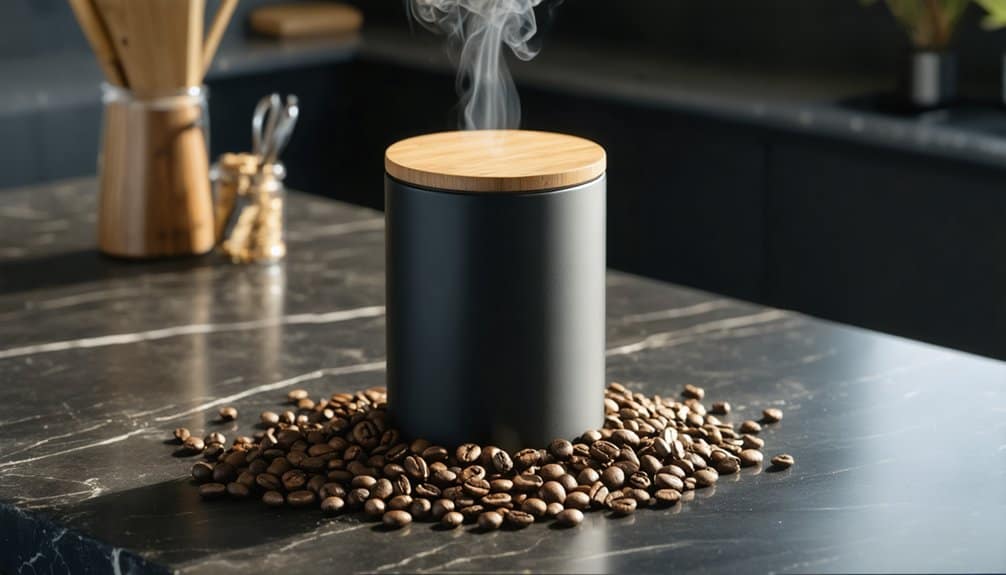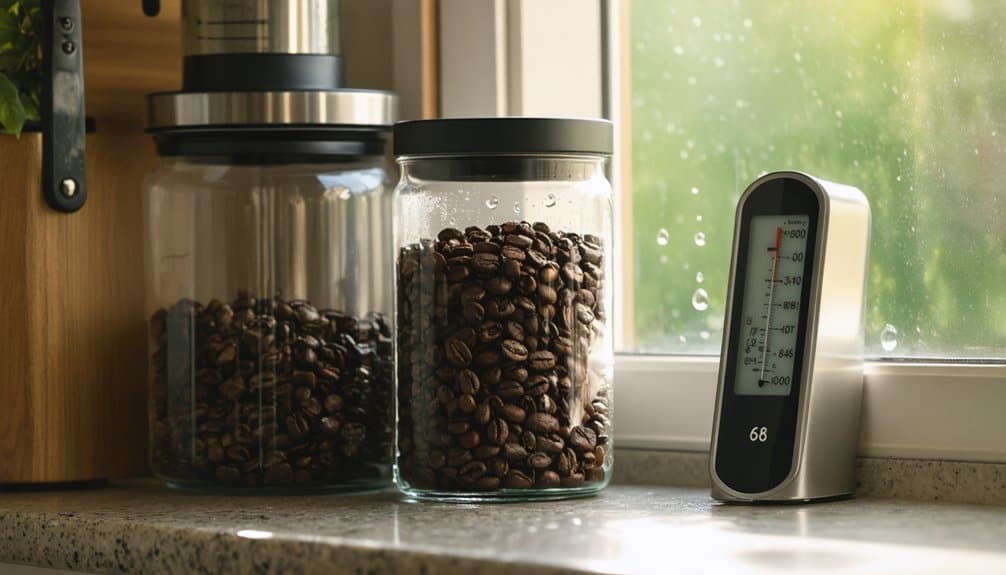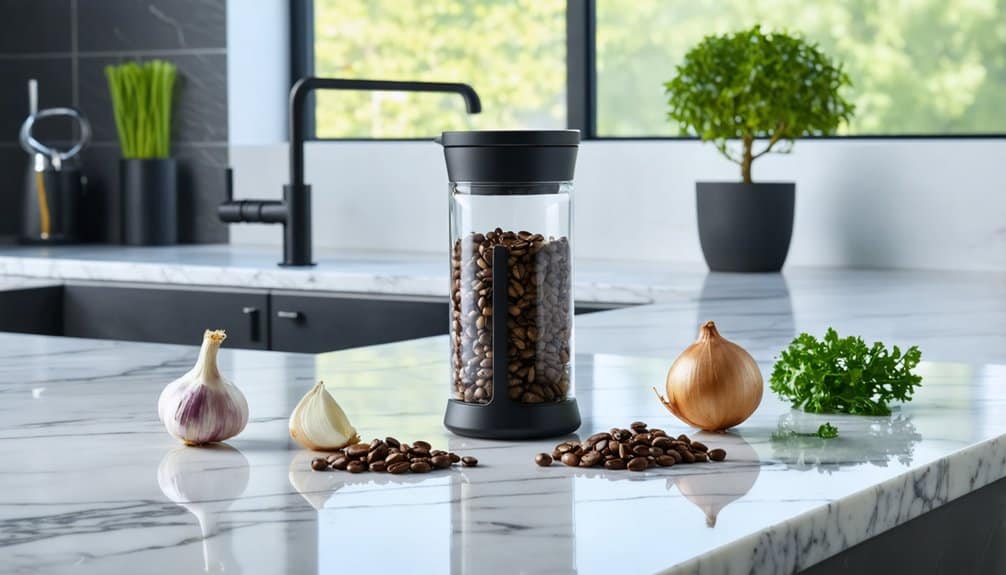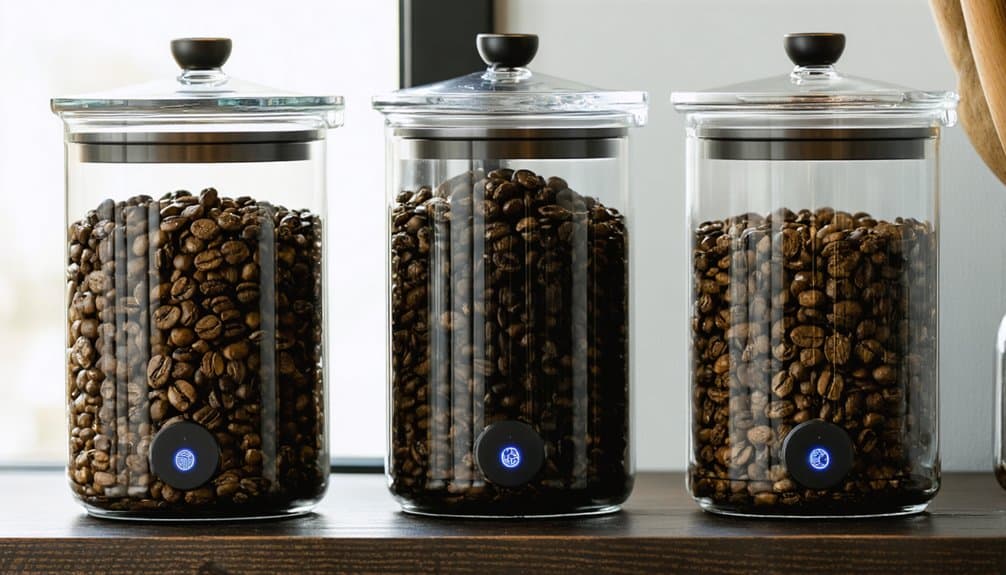Store your coffee beans in an airtight, opaque container to protect against oxidation and light damage. Keep them in a cool, dark place at 60-70°F, away from heat sources and humidity. Don't refrigerate or expose beans to strong odors, as they'll absorb surrounding scents. Buy only what you'll use within two weeks, and handle beans gently to maintain quality. For ideal freshness, consider vacuum-sealed storage systems – there's more to uncover about maximizing your beans' potential.
Key Takeaways
- Store beans in an airtight container made of stainless steel, opaque plastic, or tinted glass to protect against light and air.
- Keep coffee beans at room temperature (60-70°F) in a dark, cool place away from direct sunlight and heat sources.
- Buy only enough beans for 1-2 weeks of consumption to ensure optimal freshness and flavor quality.
- Avoid storing beans in humid areas or near moisture sources, as humidity can promote mold growth and affect taste.
- Use containers with one-way valves or vacuum seals to minimize oxygen exposure and extend shelf life by up to 50%.
Select the Perfect Airtight Container

When selecting an airtight container for coffee beans, you'll need to ponder four key factors: material, sealing mechanism, size, and maintenance requirements.
Choose stainless steel for peak durability, or opt for opaque plastic or tinted glass to protect your beans from UV exposure. You'll want a container with either a vacuum seal or one-way valve system to minimize oxygen contact. Consider your typical coffee consumption when selecting size – Fellow Atmos offers compact options, while Airscape Kilo accommodates larger quantities. Don't overlook cleanability – look for dishwasher-safe components and easily accessible corners to maintain your container's hygiene. Proper storage in these containers can increase shelf life by 50% when using vacuum-sealed options like the Fellow Atmos.
Find the Ideal Storage Location
Since proper storage location greatly influences coffee bean freshness, you'll need to take into account three critical environmental factors: light exposure, humidity levels, and temperature control.
Store your beans in dark places like cabinets, pantries, or drawers to prevent sunlight degradation. Keep them away from humid areas such as bathrooms, laundry rooms, or near sinks to avoid moisture absorption. Maintain an ideal temperature between 60-70°F by placing beans away from heat sources like stovetops, ovens, and radiators. Using glass or ceramic containers offers excellent protection while storing your beans in these locations.
For short-term storage, use your beans' original packaging or transfer them to airtight containers, keeping them in these prime conditions.
Control Temperature and Humidity

To maintain ideal coffee bean freshness, you'll need to manage two crucial environmental factors: temperature and humidity. Keep your beans at room temperature, between 50-70°F (10-21°C), and protect them from moisture exposure. Excessive heat can severely compromise coffee bean quality and accelerate the aging process.
| Factor | Do | Don't |
|---|---|---|
| Temperature | Store at 70°F (21°C) | Expose to heat sources |
| Humidity | Use airtight containers | Store in damp areas |
| Storage | Choose opaque containers | Use refrigerator/freezer |
While freezing can preserve beans when done correctly, it requires careful handling. Use vacuum-sealed bags for single servings and thaw at room temperature to prevent condensation. Remember, you'll want to avoid temperature fluctuations and high humidity, as these accelerate flavor degradation.
Buy Fresh and Store Smart
While freshness remains the cornerstone of great coffee, buying and storing your beans strategically makes a significant difference in preserving their quality. You'll want to purchase only what you'll use within one to two weeks, keeping batches small to maintain ideal flavor and aroma. Whole beans can last up to four weeks after opening when stored properly.
Store your beans in opaque, airtight containers equipped with one-way valves, placing them in cool, dark locations away from heat sources and direct sunlight. For improved protection, consider vacuum storage systems or specialized barrier bags. If you're planning long-term storage, heavy-duty containers with secure lids will serve you well, helping maintain your coffee's integrity.
Keep Beans Away From Strong Odors

Coffee beans are highly porous and readily absorb surrounding odors, which can greatly alter their intended flavor profile. You'll want to store your beans in airtight containers made of glass, porcelain, or metal, avoiding plastic which can allow odors to seep through. Consistent temperatures help maintain the stability of natural coffee oils. Keep your coffee away from strong-smelling items like spices and cleaning products. Don't store beans near your oven or refrigerator, where cooking odors and moisture can compromise their quality. Instead, choose a cool, dry pantry or cupboard that's away from direct light. For best results, purchase smaller quantities and clean your storage containers regularly to maintain your coffee's pristine flavor.
Handle Beans With Care
Beyond protecting beans from odors, proper handling techniques play a significant role in preserving their quality. You'll want to expose your beans to air as briefly as possible during each use, treating them like the delicate gems they are.
Store your coffee in small batches to maintain ideal freshness, and always label your containers with roasting and opening dates. Like coffees processed through the wet-hulled method, careful handling prevents damage that could affect flavor quality. You're safest using opaque containers made of glass or metal, filling them to the top to minimize air content. Remember to handle your beans gently, avoiding rough transfers that could damage them. Consistency in your storage routine guarantees even aging.
Master Long-Term Storage Solutions

If you're considering freezer storage for your coffee beans, you'll need to use an airtight container and remove as much air as possible to prevent moisture and freezer burn. Your beans should be stored in single-serving portions to minimize repeated freezer exposure when you need to retrieve them. Keep temperature and humidity levels consistent by storing beans in the back of your freezer, away from the door where fluctuations occur most frequently. Properly frozen beans can maintain their freshness for 3-4 months when stored correctly.
Freezer Storage Best Practices
Mastering long-term coffee storage in your freezer requires three essential elements: airtight containers, proper moisture control, and strategic batch planning.
For best preservation, you'll need opaque, vacuum-sealed containers that protect your beans from light and air exposure. Don't rely on original packaging. When storing, divide your coffee into smaller portions to minimize exposure during retrieval. Increased moisture absorption can occur if beans are not properly sealed, leading to flavor deterioration.
- Use dedicated containers labeled with storage dates
- Allow beans to reach room temperature before opening
- Keep containers in a stable freezer location to prevent temperature fluctuations
Minimize Temperature and Humidity
While proper freezer storage offers one solution for coffee preservation, maintaining precise temperature and humidity control provides the foundation for ideal long-term bean storage. You'll want to keep your beans within 50°F to 70°F, avoiding temperature fluctuations that accelerate staling. Maintain a consistently cool environment to preserve vital oils and flavors. Using high-quality airtight containers ensures optimal freshness and flavor retention over time.
Control humidity by using airtight containers and avoiding moisture-prone areas like near ovens or refrigerators. Store your beans in a cool, dry place away from direct sunlight, using opaque containers filled to the top. These measures prevent moisture from seeping in, which can lead to bitter taste and mold growth.
FAQs
Can Flavored Coffee Beans Contaminate Storage Containers With Their Artificial Flavoring?
Yes, you'll find that flavored coffee beans' artificial flavorings contain solvents that can leave persistent chemical residues in your containers, risking contamination of future coffee batches you'll store there.
How Long Do Coffee Beans Stay Fresh After the Roast Date?
Like a butterfly emerging from its cocoon, your coffee beans hit peak flavor 48 hours post-roast. You'll get ideal taste for 2 weeks, though they're still drinkable up to 30 days with proper storage.
Should I Vacuum Seal Small Portions for Daily Use?
You'll benefit from vacuum sealing small portions, as it protects your daily coffee from oxidation. However, you'll need degassing valves for freshly roasted beans to prevent CO2 buildup and bursting.
What Signs Indicate Coffee Beans Have Gone Stale?
Within 2-3 weeks, you'll notice your coffee beans turning dull and losing their sheen. Watch for faded colors, brittle texture, and muted aromas that signal staleness in your beans.
Can I Mix Different Roasts in the Same Storage Container?
You shouldn't mix different roasts in one container, as they'll release CO2 at varying rates and affect each other's flavors. Keep your roasts separate to maintain their distinct characteristics.
The Bottom Line
By following these crucial storage tips, you'll transform your coffee beans from vulnerable flavor victims into protected flavor powerhouses. You're now equipped to shield them from their archenemies: light, heat, moisture, and air. With your airtight fortress and precise temperature control, you'll guarantee every cup delivers the exact molecular composition of flavors you're seeking. Your beans won't just survive – they'll thrive under your methodical care.